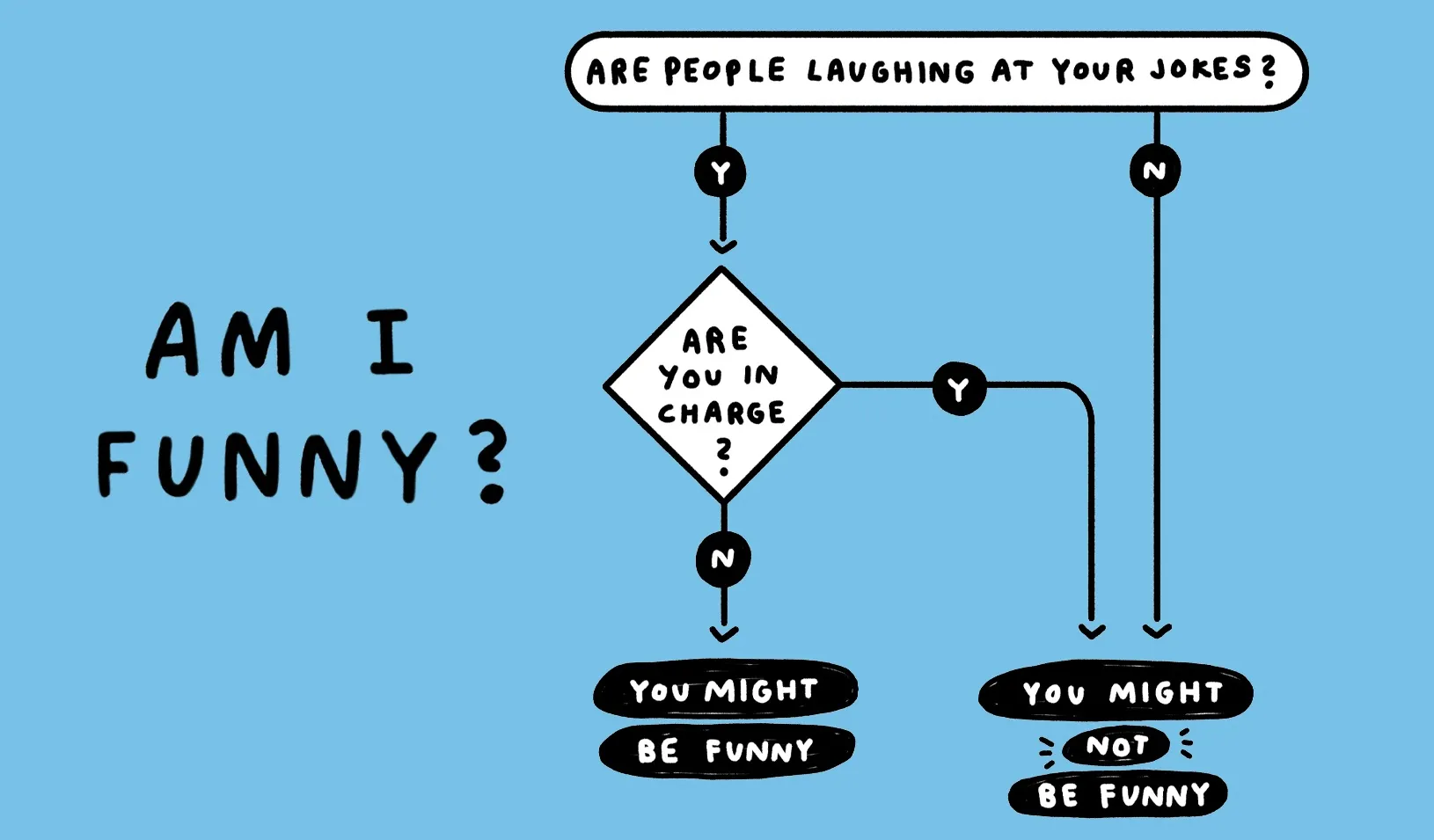This Is Not a Joke: The Cost of Being Humorless
Humor has tremendous benefits for physical health, mental well-being, and your bottom line.
January 28, 2021

Remarkable and effective leaders harness humor to enhance their power — while earning the trust of those they lead.| Illustration by Michelle Rial
Judd Apatow told me that the Best Picture Oscar nominations irked him, because they’re all dramas, and all dramas are a lie. There’s a war, or a cancer, or a poor family in Seoul conning a rich family in Seoul by pretending they have skills they don’t have, which then gets really violent for reasons no one can remember. The characters react to these tragedies by yelling, crying, moping, and never making any jokes. Which is not how people act during war or cancer or probably the Seoul thing. It’s how people who have never experienced trauma assume they’ll act.
We don’t know how to act during a pandemic. So we’re putting on a character. We’re withholding our jokes out of fear that it will hurt someone who is experiencing COVID-related suffering, home-school-related suffering, end-of-democracy suffering, or have-to-pretend-to-be-amused-by-your-Zoom-fake-background suffering.
But as risk-reward analysis shows time and time again, a lack of risk costs us rewards. A 15-year longitudinal study of more than 50,000 Norwegians found that women with a strong sense of humor had a 73% lower risk of dying from heart disease and an 83% lower risk of dying from infection. Men who scored high on humor experience similar benefits and also have a significantly higher percent chance of getting laid, which is much more important to us than avoiding heart disease or infection.
Avoiding disease does seem like a pretty big upside right now, though. And that same study of Norwegians showed that people with a sense of humor lived eight years longer. Though there’s a much greater opportunity for growth for Norwegians than any other nationality. The only Norwegian comedian anyone has ever heard of is Espen Eckbo, star of the show Mandagsklubben. The takeaway here is that foreign words are funny.
Humor helps directly with your bottom line, too. Employees who rate their bosses as having any sense of humor at all are 15% more satisfied in their jobs and rate their bosses as 27% more motivating and admired. Even a lighthearted line at the end of a sales pitch increases customers’ willingness to pay by 18%. A study from Harvard Business School showed that putting a lame pun at the end of testimonials as to why people should visit Switzerland (“the flag is a big plus”) made readers think the person who wrote it was 37% higher in status, and also more competent and confident. Participants in the study were much more likely to pick the dad-flag-joke teller as their group leader. There are apparently limits to how much competence people award you for being funny, since no one is putting Dave Chappelle in charge of vaccine distribution. But if the vaccine distribution guy were a little funnier, perhaps we’d be out of this mess by now. I’m not great at interpreting studies.
Still, when I read Humor, Seriously: Why Humor Is a Secret Weapon in Business and Life, the new book by Stanford Graduate School of Business professor Jennifer Aaker and lecturer Naomi Bagdonas, I got nervous about applying their rules to my pandemic work situation. It’s one thing to complain about the Oscars; it’s another to risk your professional reputation on a joke about someone’s cough on a Zoom call.
Still, I knew I had to give it a shot. The first lesson from the book I used is that humor isn’t about inventing something, but finding what’s true and naming it. “Instead of asking yourself what is funny,” they write, “start by asking what is true.” When I read that, I instantly knew what the truth was. And naming it was going to get a big laugh.
I went to deliver my one-liner to my coworkers, who are my wife and 11-year-old son, and really only coworkers in the sense that coworkers are people who come into your office and interrupt you with their problems. I cleared my voice and delivered the hilarious truth: “I’m sick of being with you guys all day.”
The two technical comedy terms for what happened next were “bomb” and “commencing divorce proceedings.”
But after a humor disaster, the book says not to give up. Humor isn’t innate, as most people assume. It’s a muscle that must be exercised and strengthened, much like a muscle. One exercise is to improve your analogy building.
So I started training. Aaker and Bagdonas teach that, much like magic, humor is an unexpected surprise, which is sometimes called the Incongruity-Resolution Theory, because academics who study humor are the only people nerdier than magicians. Jokes and magic tricks use the same technique: misdirection. In jokes, one shortcut way to do this is to use the “rule of three.” You set up a pattern with two items, and add a third that doesn’t fit. For instance, the third time your editor asks you to put in a paragraph about the rule of three, you listen, process, and write that bit about Parasite.
See, I acknowledged the truth there, and it was such a great success that I figured I’d try it again. Only, unlike what I did with my family, this time I would add introspection and empathy. I learned this from a story about Connor Diemand-Yauman, who recently became the co-CEO of Merit America. For his first all-hands Zoom as the co-CEO last year, Connor wasn’t sure how to communicate his genuine concern for the hardship his employees were facing, because America wasn’t doing well despite all the merit his company was delivering to it. To acknowledge this truth, he pretended to leave his screen-share on and, as every employee held their breath watching, Googled “things inspirational CEOs say in hard times.” He got a laugh, which allowed his employees to relax and and feel free to be creative. The lesson is that the bar for being funny in an all-hands meeting is really low. Work is so boring that it’s a nearly perfectly inefficient humor market. There is a real chance that Carrot Top could revive his career by appearing at board meetings.
But even if Connor’s stunt hadn’t gotten a laugh, it would have been a win; research shows that a joke that falls flat, as long as it isn’t deemed inappropriate, still leads people to rate you as more confident.
Aaker and Bagdonas use a chart to explain this:

Even a joke that didn’t get a laugh still leaves you better off if it’s seen as appropriate.| Illustration by Jensen Neff
Unfortunately, telling my wife and son that I needed to get away from them put me into the bottom left quadrant of the chart, which is the quadrant you never want to be in, in any chart that’s not about marching troops into Russia in the winter.

Charles Joseph Minard’s famous infographic showing the losses suffered by Napoleon’s army in the Russian campaign of 1812. | Courtesy of Princeton Architectural Press
What people want, even more than a laugh, is joy. As the writer Michael Lewis says in the book’s afterword, making a joke isn’t a risk. Not making one is. “People don’t want to have a boring life, or even a boring conversation. They’re just risk-averse. If you create an environment where there’s no reason to be afraid, all of a sudden things loosen up.” When you’re in a mindset of looking for humor, you’re in the flow. You’re present — listening to what someone is saying, observing what’s going on, thinking about what the other people are feeling, all so you can interrupt and make fun of them.
With this new mindset, I re-amassed my humor troops and decided to try out another lesson on an actual business Zoom with executives from a podcast company I was pitching ideas to. One lesson in the book is that setting a funny tone before a meeting starts can unlock creativity later on. Aaker and Bagdonas tell the story of how Stephen Curry changed the tone by ending a speech he was delivering to more than 40 corporate partners by saying, “I’d like to conclude with my favorite Steve Ballmer impression.” Then he puffed out his chest and yelled, “WHO’S FIRED UP TO BE HERE?!?!? I’M FIRED UP!!!!!! I’M FIRED UP TO BE HERE! IF YOU AREN’T FIRED UP, IT’S YOUR FAULT!! WHO’S FIRED UP??!!”
During my pitch, I noticed I was rotely telling my story, without being present. I interrupted myself and said, “I’d like to do my favorite impression of Stephen Curry doing a Steve Ballmer impression.” What I learned is that people laugh a lot more easily if the person telling the joke has three NBA championships.
Despite my inability to crack the top left quadrant of the failure chart, I had avoided a whole other chart where all four quadrants are bad: the chart of seriousness. The quadrants there are robot, living in fear, unempathetic, and unable to use the same part of speech in a list. It’s a pandemic. You can’t afford to not be human. And there are few things more human than laughing. Humor is honesty, it’s being observant, it’s being present. And if that’s not what we need now, then I don’t know what is. Probably the vaccine. We really should get Chappelle on that.
Humor, Seriously will be available for purchase beginning February 2, 2021. Anyone who pre-orders a hardcover copy is eligible to receive an early digital edition by entering their contact information.
For media inquiries, visit the Newsroom.
Explore More

12 Stories About Gender, Power, and Progress for Women’s History Month

Speaking Up Without Freaking Out: How to Tackle Communication Anxiety



